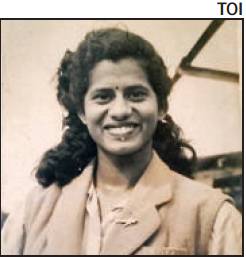Mary D’Souza
This is a collection of articles archived for the excellence of their content. |
Mumbai’s first woman Olympian
Sharmila Ganesan, July 4, 2021: The Times of India

From: Sharmila Ganesan, July 4, 2021: The Times of India
In 1950s Bandra, every time someone would ask Francis Sequeira how he met or rather “caught up” with his Olympian wife Mary D’Souza--who could run an 80-metre hurdle race in less than 13 seconds--the oil firm employee would say: “I waited for her at the tape.” Outpaced by her husband only in wit, D’Souza, a track-and-field athlete and field hockey champion who had met Sequeira at a picnic a few years after she became one of India’s first four women Olympians in 1952, was his equal in marriage. Leaving her two kids in the care of her husband and a full-time maid, the railway sports recruiter travelled widely with her first love, the hockey stick. This sort of freedom had eluded her as the seventh of 12 children of a domineering motorman who would say if she needed exercise she “should sweep the floors and do chores at home instead of running around like a mad woman”.
As she turns a nimble 90 this month in the US’ Atlanta, D’Souza--who stays up to play online bridge and goes on long walks--feels age is catching up with her. Leaping over forgettable memories of divided skirts and divided convent schools, in which Anglo-Indian children never mingled with regular Indian kids, the veteran pines for the rental bungalows, airy beaches and songand-dance picnics of the suburb in which she grew up in 151 Hill Road. “We could walk to the railway station and play hockey on the municipal ground behind our building,” says D’Souza, who earned her stripes in hockey by being the only girl who played the sport with the boys.
D’Souza darted her way coachless into the nationals and got selected for the First Asian Games in Delhi in 1951 where she broke the national record in the 200-metre hurdle race. And just like that, at age 20, D’Souza made it into the list of eight athletes meant to represent India at the Olympics in Finland’s Helsinki in 1952. In the chartered flight from Dum Dum airport to Helsinki, bindi-sporting D’Souza was the only female athlete from Bombay.